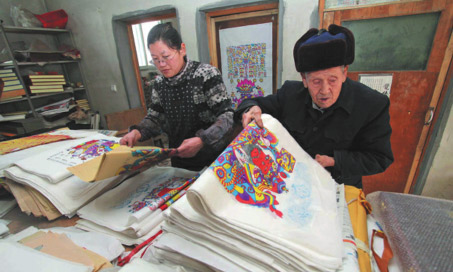 |
|
Yang Luoshu, 92, right, from Weifang, Shandong province, is among those who have had great passion for the Chinese Lunar New Year woodblock prints. [PHOTO BY ZHANG CHI/FOR CHINA DAILY] |
JINAN - A cherubic child holding a big fish, a giant tree bearing golden coins as fruit, or delicate woodblock paintings are all often hung at homes during the Chinese Lunar New Year. For many Chinese, bright-colored woodblock paintings, which are hung at almost every door, windows and walls for festival decorations, are quite time-limited. As soon as the parties come to an end, these print works are at once thrown away.
However, these short-lived New Year paintings require a year of hard work by the artists, many of whom have devoted their entire life to this traditional folk art.
Yang Luoshu, a 92-year-old man from Weifang, Shandong province, is among those who have had great passion for the Chinese Lunar New Year woodblock prints. Yang has worked as a craftsman for 77 years, and has kept polishing his carving skills with every piece of work.
"When I was young, I often saw my father carving, and I remember being so curious about it," Yang says. "One day my father was gone for a while. I quickly grasped his knife and carved on the woodblock. That was the very first day of my carving experience."
Yangjiabu New Year woodblock paintings, which Yang has fallen in love with, emerged in the Ming Dynasty (1368-1644) around 600 years ago. As a national intangible cultural heritage, it is now one of China's three representatives of traditional folk paintings for the New Year, together with Tianjin's Yangliuqing and Suzhou's Taohuawu.
Each made-up painting requires five steps: sketching outlines, engraving the woodblock, printing, painting and mounting, all done by hand.
Running a centuries-old folk art family workshop named Tongshunde, Yang has carved all kinds of motifs, including flowers, birds, mountains, rivers, and traditional Chinese gods, and was named a "master of folk arts" by UNESCO in 2001.
"Though engraving is hard in general, carving gods is especially difficult, with all the armor and vivid facial expressions. Still, I can manage it," Yang says.